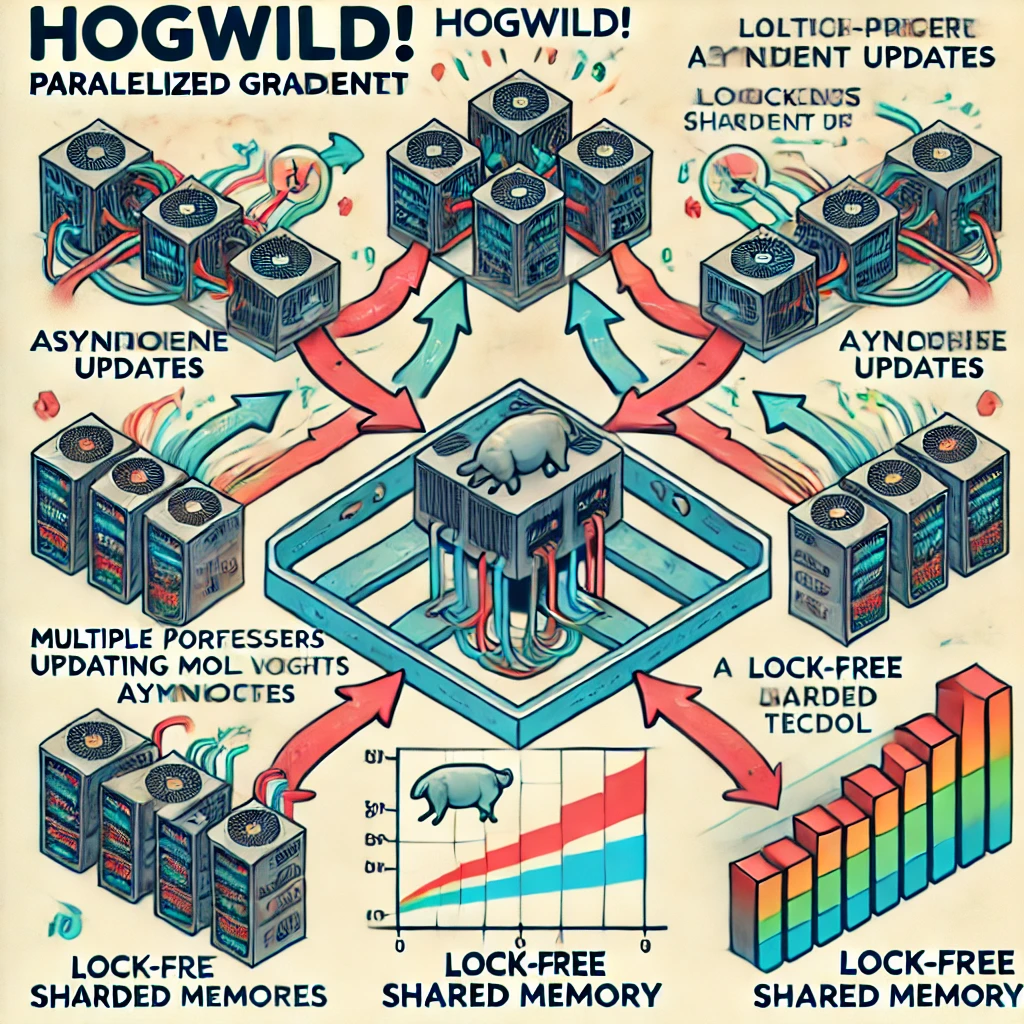comprehensive guide to Speeding Up Machine Learning with Hogwild! Parallelized Gradient Descent 2024
As machine learning models grow in complexity and data scales up, training these models becomes more computationally expensive. Traditional Stochastic Gradient Descent (SGD), while effective, can be slow when working with large datasets and complex models. One approach to address this issue is Hogwild!, a parallelized version of SGD that improves training speed by utilizing asynchronous updates in a multi-processor environment.
In this blog, we’ll break down the core concept of Hogwild!, how it parallelizes gradient updates, and explore its practical implementation for faster training in machine learning models like linear regression.
What is Hogwild!?

Hogwild! is an asynchronous variant of Stochastic Gradient Descent (SGD), designed to optimize machine learning models by leveraging parallelism. Unlike traditional SGD, which updates weights sequentially, Hogwild! allows multiple processes to update the weights simultaneously in a “lock-free” manner.
The algorithm works by storing the model weights in shared memory that can be accessed and updated by all processes at the same time. While this introduces the possibility of overwriting weights, the sparse nature of the gradients (i.e., updates to only a few elements at a time) means that these conflicts are rare and have minimal impact on the final result. Surprisingly, this parallel approach can even regularize the model, helping prevent overfitting.
Why Use Hogwild!?

The main advantage of Hogwild! is its ability to speed up training by parallelizing the gradient descent process. Here are a few reasons why it’s beneficial:
- Faster Training with Asynchronous Updates: By allowing multiple processors to update weights simultaneously, Hogwild! speeds up the training process. Each processor performs the gradient update on different data points without waiting for others to finish.
- Lock-Free Shared Memory: Unlike traditional parallel algorithms that use locks to avoid race conditions, Hogwild! does not require locks for each gradient update. This lock-free approach reduces synchronization overhead and increases training efficiency.
- Scalability: Hogwild! is especially useful for large datasets and models, as it scales well to multi-core processors, enabling faster training for complex machine learning models.
- Practical Regularization: Although multiple processes might update the same weight concurrently, this leads to a form of implicit regularization, which can help improve the generalization of the model.
How Does Hogwild! Work?

At its core, Hogwild! operates by updating the model weights asynchronously across multiple processors. Here’s how the algorithm works:
- Initialization: The model weights are initialized and stored in shared memory that all processors can access.
- Parallel Update: Each processor samples a training example, calculates the gradient, and updates the model weights asynchronously. These updates happen independently, and there’s no synchronization between processors during this process.
- Gradient Calculation: The gradient is calculated for each data point in the training set, and the weight updates are performed component-wise (i.e., updating one element of the weight vector at a time).
- Repeat: The process is repeated until the model converges or reaches a predefined stopping criterion.
Conditions for Hogwild! to Work Effectively
For Hogwild! to work efficiently, the gradients need to be sparse, meaning that most updates should affect only a small number of parameters. This is especially true when the data itself is sparse (i.e., when most of the features are zero or irrelevant).
- Sparse Gradients: Sparse updates make it unlikely for multiple processors to attempt to update the same weight component simultaneously, reducing the chance of “collisions” or conflicting updates.
- Regularization: Although collisions can happen, they tend to act as a form of regularization, improving the model’s generalization.
Hogwild! and Linear Regression
Let’s walk through an example of using Hogwild! to train a linear regression model. In linear regression, the goal is to minimize the Mean Squared Error (MSE) between the predicted outputs and actual outputs. The model parameters are updated using the gradient of the MSE loss function.
Generating Training Data
To implement Hogwild! in Python, we start by generating sparse training data using the scipy.sparse library. The data is normalized for training, and a random weight vector is generated to simulate the true weights.
pythonCopyimport scipy.sparse
import numpy as np
n = 10 # Number of features
m = 20000 # Number of training examples
# Generate sparse training data
X = scipy.sparse.random(m, n, density=0.2).toarray()
real_w = np.random.uniform(0, 1, size=(n, 1)) # True weight vector
X = X / X.max() # Normalizing for training
y = np.dot(X, real_w) # Generating the labels
Parallelizing Gradient Updates

Using Python’s multiprocessing library, we implement the Hogwild! parallel gradient update step. We create a shared weight vector accessible by all processes, and each process computes the gradient for its assigned data point.
pythonCopyfrom multiprocessing.sharedctypes import Array
from ctypes import c_double
import numpy as np
# Shared memory for weights
coef_shared = Array(c_double, (np.random.normal(size=(n, 1)) * 1. / np.sqrt(n)).flat, lock=False)
w = np.frombuffer(coef_shared).reshape((n, 1))
# Gradient update function
def mse_gradient_step(X_y_tuple):
global w
X, y = X_y_tuple
err = y.reshape((len(y), 1)) - np.dot(X, w)
grad = -2. * np.dot(np.transpose(X), err) / X.shape[0]
# Update non-zero weights
for index in np.where(abs(grad) > .01)[0]:
coef_shared[index] -= 0.001 * grad[index, 0]
Training with Multiple Processes
We then use multiprocessing.Pool to run the gradient updates in parallel across multiple workers. Each worker computes and updates the gradients asynchronously, using mini-batches of training data.
pythonCopyfrom multiprocessing import Pool
# Preparing examples for multiprocessing
batch_size = 1
examples = [None] * int(X.shape[0] / float(batch_size))
for k in range(int(X.shape[0] / float(batch_size))):
Xx = X[k * batch_size:(k + 1) * batch_size, :].reshape((batch_size, X.shape[1]))
yy = y[k * batch_size:(k + 1) * batch_size].reshape((batch_size, 1))
examples[k] = (Xx, yy)
# Using Pool to run the gradient updates in parallel
p = Pool(5)
p.map(mse_gradient_step, examples)
# Print results
print('Loss function on the training set:', np.mean(abs(y - np.dot(X, w))))
print('Difference from the real weight vector:', abs(real_w - w).sum())
Advantages and Applications of Hogwild!
- Speed: Hogwild! enables faster training by parallelizing gradient descent, particularly when dealing with large datasets.
- Scalability: The approach scales well with the number of processors, making it ideal for distributed systems.
- Regularization: As mentioned earlier, collisions during updates can act as a form of regularization, preventing overfitting in some cases.
Conclusion: Why Hogwild! Works
Hogwild! provides a simple yet powerful approach to parallelizing gradient descent. By utilizing asynchronous updates and leveraging lock-free shared memory, it accelerates training without needing complex synchronization mechanisms. While it requires sparse data and gradient updates to work most effectively, the algorithm has proven to be a useful tool in optimizing machine learning workflows, particularly in large-scale scenarios where training time can be a bottleneck.
Asynchronous methods like Hogwild! are likely to become more important in reinforcement learning and other domains that require real-time, large-scale training, making them a valuable addition to modern machine learning toolkits.